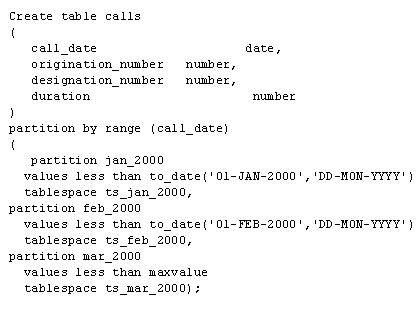Create Oracle Partitioned table - Exercise Result
You entered:
The student should note that the key is a date value. As such, there are several acceptable answers to this problem. Here is one acceptable option:

partition by range (call_date)
(
partition jan_2020
values less than to_date('01-JAN-2020', 'DD-MON-YYYY')
tablespace ts_jan_2020,
partition feb_2020
values less than to_date ('01-FEB-2020', 'DD-MON-YYYY')
tablespace ts_feb_2020,
partition mar_2020
values less than maxvalue
tablespace ts_mar_2020);
Tuning with Oracle partitioning
You probably agree that partitioning can be extremely complex.
- How might you apply what you know about partitioning on the job?
- What problems have you encountered with creating partitions?
Some of the Challenges encountered when creating Partitions in Oracle
In the realm of Oracle database administration, partitioning is a widely acknowledged strategy for enhancing performance and manageability, particularly in large databases. However, the process of creating partitions in Oracle databases is accompanied by a set of challenges that require careful consideration and adept handling. These challenges include:
Navigating these challenges requires a strategic approach, encompassing careful planning, thorough testing, and ongoing monitoring and adjustment of the partitioning scheme. A well-implemented partitioning strategy can significantly enhance the performance, scalability, and manageability of Oracle databases, but it demands a high level of expertise and attention to detail from the database administrator.
- Complexity in Design: Designing an effective partitioning strategy demands a profound understanding of the database schema, the nature of the data, and the access patterns of the applications utilizing the database. Selecting the appropriate partitioning key, partition type (range, list, hash, composite), and partition granularity requires meticulous planning to ensure that the partitioning scheme aligns with query patterns and data distribution, optimizing performance while avoiding unnecessary complexity.
- Data Skew: One of the significant challenges in partitioning is avoiding data skew, where one or more partitions end up storing a disproportionately large amount of data compared to others. This imbalance can lead to performance bottlenecks, as queries targeting the larger partitions may exhibit degraded performance. Achieving an even distribution of data across partitions necessitates a careful choice of partition keys and ongoing monitoring.
- Partition Maintenance Overhead: As data evolves, partition maintenance tasks such as adding, dropping, splitting, and merging partitions become necessary. These operations can be resource-intensive and may require significant downtime if not managed properly. Automating maintenance tasks and scheduling them during off-peak hours can mitigate their impact, but they still require diligent planning and testing.
- Index Management: Partitioning introduces complexity in index management. Local and global indexes have their own advantages and drawbacks, and choosing the correct index type is crucial for performance. Local indexes are easier to manage and can improve performance for queries that are partition-pruned, but they might not be suitable for all queries. Global indexes, on the other hand, can provide faster access paths for certain queries but may become a maintenance challenge, especially during partition maintenance operations.
- Data Access Path Changes: Implementing partitioning can change the optimal access paths for queries. Queries that were previously performing well might experience performance degradation if they are not effectively utilizing the partitioning scheme. Ensuring that the database optimizer has accurate statistics and understands the partitioning layout is critical for maintaining optimal query performance.
- Cost of Re-partitioning: If the initial partitioning strategy proves to be suboptimal, re-partitioning the data can be a costly and time-consuming process. It often involves extensive data movement and application downtime, which can be disruptive to business operations. Thorough testing and validation of the partitioning strategy before implementation are essential to minimize the need for re-partitioning.
- Storage and Resource Considerations: Partitioning can lead to an increase in storage requirements due to the additional structures and metadata associated with each partition. It can also impact resource utilization, as queries that do not effectively leverage partition pruning may end up scanning multiple partitions unnecessarily, leading to increased I/O and CPU usage.
- Compatibility and Feature Restrictions: Certain Oracle features and tools may have restrictions or behave differently when used with partitioned tables. Understanding these limitations and planning for potential impacts on features such as replication, backup and recovery, and data warehousing is crucial for a successful partitioning strategy.
Navigating these challenges requires a strategic approach, encompassing careful planning, thorough testing, and ongoing monitoring and adjustment of the partitioning scheme. A well-implemented partitioning strategy can significantly enhance the performance, scalability, and manageability of Oracle databases, but it demands a high level of expertise and attention to detail from the database administrator.